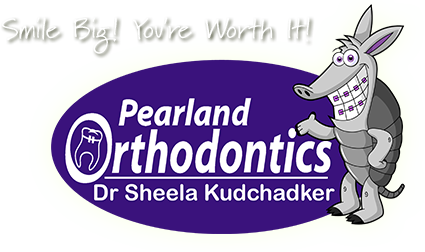Headgear | Facemask (Reverse Headgear) | Lower Lingual Arch | Forsus | Expander (RPE) | Thumb/Finger Appliance | Lip Bumper | Tongue Thrusting Appliance | Interproximal Recontouring | TAD's | TPA (Trans-Palatal Arch | Separators | Elastics
Headgear
Headgear is often used to correct an excessive overbite. This is done by placing pressure against the upper teeth and jaw, which would hold the teeth in position or help move them into better positions. The severity of the problem determines the length of time headgear needs to be worn. The key to success with your headgear appliance is consistency. Headgear must be worn a certain number of hours per day, and if not, it must be made up the following day.
Headgear should never be worn while playing sports and should also be removed while eating or brushing your teeth.
Facemask (Reverse Headgear)
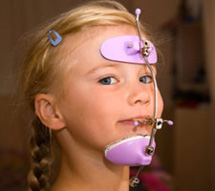 In some cases where an underbite is present, we may recommend using reverse headgear (face mask) as part of the treatment plan. This appliance is designed to fix the discrepancy between your upper and lower jaws by moving the upper jaw forward to correct the malocclusion.
In some cases where an underbite is present, we may recommend using reverse headgear (face mask) as part of the treatment plan. This appliance is designed to fix the discrepancy between your upper and lower jaws by moving the upper jaw forward to correct the malocclusion.
For the results to be successful, patient compliance is of the utmost importance. It may take several days to become accustomed to the appliance. With practice, it will become easier to place and remove the reverse headgear. We will determine the length of time you should wear your headgear, but it is generally 10-14 hours per day, which can include wearing while you sleep. You should not wear your headgear while participating in sporting activities.
Sometimes your chin may get irritated from the headgear. If this happens, you should always keep the area clean and often change the insert in the chin cup. If the skin becomes very dry, the use of moisturizing cream twice a day can be helpful. If your jaw joints are extremely sore or you cannot open and close your mouth without difficulty, stop wearing the appliance and contact us for further instructions as we may need to fit you with a different appliance. Also, if your headgear breaks or is bent, call us so we can fit you in with a repair appointment so your treatment will not be delayed.
Lower Lingual Arch
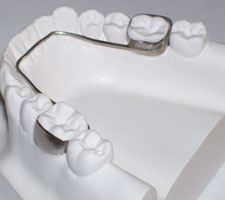 A Lower Lingual Arch acts as a space maintainer to keep the molars from drifting forward, and prevent them from blocking the space where permanent teeth will eventually erupt. This appliance is commonly used in cases of premature loss of baby tooth or when the lower teeth of a growing child are slightly crowded and no permanent teeth are extracted to correct the problem.
A Lower Lingual Arch acts as a space maintainer to keep the molars from drifting forward, and prevent them from blocking the space where permanent teeth will eventually erupt. This appliance is commonly used in cases of premature loss of baby tooth or when the lower teeth of a growing child are slightly crowded and no permanent teeth are extracted to correct the problem.
You should expect soreness the first day or two, and it may hurt to chew. We recommend a soft diet initially. You may take Advil or Tylenol to relieve the pain. Avoid sticky or hard foods, and please monitor how many foods you eat that are high in sugar.
Brushing and flossing daily is very important. Be sure to clean around the bands that are connected to the molars and the wire on the tongue side. This will prevent the formation of cavities or infection of the gums.
The duration of wear varies. We will monitor the eruption of new teeth and make adjustments. Generally, the Lower Lingual Arch is removed following the eruption of all the permanent teeth.
Forsus
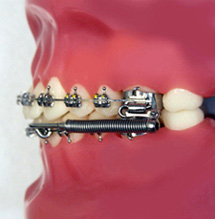 The Forsus appliance is used in order to help move the upper molars back while moving the lower arch forward. Composed of a spring coil rod, the appliance is used while a patient is currently wearing braces. It runs from the upper first molar band down to the lower archwire.
The Forsus appliance is used in order to help move the upper molars back while moving the lower arch forward. Composed of a spring coil rod, the appliance is used while a patient is currently wearing braces. It runs from the upper first molar band down to the lower archwire.
You may notice some discomfort initially, so we recommend a soft food diet for the first few days after the appliance is placed. Regular anti-inflammatory medication may help with any pain, if needed. It is important to keep the appliance clean; you may do this by carefully brushing the coil and other metal pieces of the appliance. Also, we recommend that patients not open their mouths very wide, as the appliance may come apart.
If your Forsus appliance breaks, please contact our office immediately to schedule a repair appointment.
Expander (RPE)
Attached to the upper molars through bonding or by cemented bands, the Rapid Palatal Expander is an orthodontic device used to create a wider space in the upper jaw. It is typically used when the upper jaw is too narrow for the lower jaw or when the upper teeth are crowded or blocked out of the dental arch.
When patients are still growing, their connective tissue between the left and right halves of their upper jaw is very responsive to expansion. By simply activating the expander through turning a screw in the center, with a special key we provide, gradual outward pressure is placed on the left and right halves of the upper jaw. This pressure causes an increased amount of bone to grow between the right and left halves of the jaw, ultimately resulting in an increased width.
Thumb/Finger Appliance
Sucking is a natural reflex that relaxes and comforts babies and toddlers. Children usually cease thumb sucking when the permanent front teeth are ready to erupt. Typically, children stop between the ages of 2 and 4 years. Thumb sucking that persists beyond the eruption of primary teeth can cause improper growth of the mouth and misalignment of the teeth. If you notice prolonged and/or vigorous thumb sucking behavior in your child, talk to your dentist.
One solution to thumb sucking is an appliance called a "fixed palatal crib." This appliance is put on the child's upper teeth by an orthodontist. It's placed behind on the upper teeth on the roof of the mouth. The crib consists of semicircular stainless steel wires that are fastened to molars using steel bands. The stainless steel wires fit behind the child's upper front teeth, and they are barely visible. The crib usually stops the habit of thumb sucking within the first day of use.
Lip Bumpers
We like to avoid pulling teeth as often as possible, so we use lip bumpers on our patients who need to create more room for their crowded teeth. The lip bumper is a wire on the lower jaw that extends from one molar to another and keeps lips and cheeks from touching your teeth. When you move your mouth or speak, your lips and cheeks push on the bumper, and the bumper applies pressure to the teeth. This pressure pushes the molars back, creating more space for overcrowded teeth.
If you have a lip bumper, please remember to leave it in while eating, but do not eat hard or sticky foods. Proper, thorough brushing should remove any food that gets stuck in your lip bumper.
Tongue Thrusting Appliance
Tongue thrusting occurs when the patient presses his or her tongue against the front teeth, usually when swallowing, speaking or resting the tongue. If thrusting is constant, this can cause problems with teeth alignment and must be fixed.
We prefer to correct tongue thrusting by giving patients a tongue thrusting appliance. This appliance, similar to a mouth guard, is usually worn at night. Other times, a more permanent appliance is prescribed and can be only be adjusted by our office.
Interproximal Recontouring
Interproximal recontouring refers to a procedure in which the orthodontist will reshape your teeth by sculpting the sides of the teeth. This can correct cracked, chipped, crooked or misaligned teeth. Instead of braces, crowns or veneers, you can choose to have interproximal recontouring to change the shape and look of your teeth to enhance your smile!
TAD's
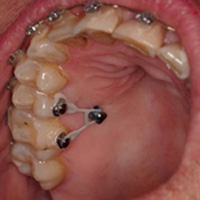 One of the many important advances in orthodontics has been the development of temporary anchorage devices, or TADs. Made of a bio-compatible titanium alloy, TADs are miniscrew anchors which are inserted into specific places in the mouth to be used as a fixed point from which teeth can move. Before TADs, orthodontists who wanted to move some teeth while keeping others still, or to achieve orthodontic movement in a mouth with missing teeth, had to rely on headgear for their fixed point. But TADs now provide an option for that fixed point that is smaller, more discrete, more efficient and requires significantly less work for the patient.
One of the many important advances in orthodontics has been the development of temporary anchorage devices, or TADs. Made of a bio-compatible titanium alloy, TADs are miniscrew anchors which are inserted into specific places in the mouth to be used as a fixed point from which teeth can move. Before TADs, orthodontists who wanted to move some teeth while keeping others still, or to achieve orthodontic movement in a mouth with missing teeth, had to rely on headgear for their fixed point. But TADs now provide an option for that fixed point that is smaller, more discrete, more efficient and requires significantly less work for the patient.
Temporary anchorage devices may not be recommended for everyone, and in fact, anchorage devices at all may not be needed in all cases. Contact us if you'd like to know more about TADs and how they can potentially prevent you from needing orthodontic headgear.
TPA (Trans-Palatal Arch)
The Trans-Palatal Arch is an orthodontic appliance used to maintain the upper jaw's arch width and move molars into positions that wires alone can't. The appliance is banded around the first molars on each side of the mouth, and a thin wire spans across the roof of the mouth.
Patients should be sure to brush and their appliance daily. Also, avoid sticky, chewy or hard foods as these can get caught between the appliance and the roof of your mouth. These foods may also break your Trans-Palatal Arch.
Separators
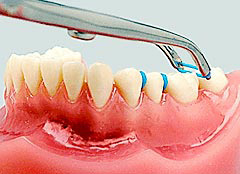 Separators are small elastics that fit snugly between certain teeth to move them slightly so bands can be placed around them later. Separators can fall out on their own if enough space has already been created. To determine if it needs to be replaced, slip some dental floss between the teeth; if it gets stuck, that means the separator hasn't created enough room and needs to be replaced prior to your banding appointment.
Separators are small elastics that fit snugly between certain teeth to move them slightly so bands can be placed around them later. Separators can fall out on their own if enough space has already been created. To determine if it needs to be replaced, slip some dental floss between the teeth; if it gets stuck, that means the separator hasn't created enough room and needs to be replaced prior to your banding appointment.
Elastics
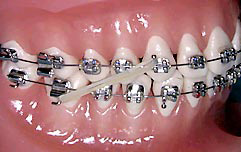 Elastics are a vital part of treatment and are also contingent upon patient compliance. They add extra pressure to the braces to help move the teeth. Generally worn at all times (excluding eating and brushing your teeth), elastics should be changed at least once a day. They come in various sizes as they are each used for a specific purpose. We will provide you with the appropriate size.
Elastics are a vital part of treatment and are also contingent upon patient compliance. They add extra pressure to the braces to help move the teeth. Generally worn at all times (excluding eating and brushing your teeth), elastics should be changed at least once a day. They come in various sizes as they are each used for a specific purpose. We will provide you with the appropriate size.
It is important to wear them consistently or treatment setbacks may occur. If only one day is missed, it could cause your teeth to shift back to their original position!

